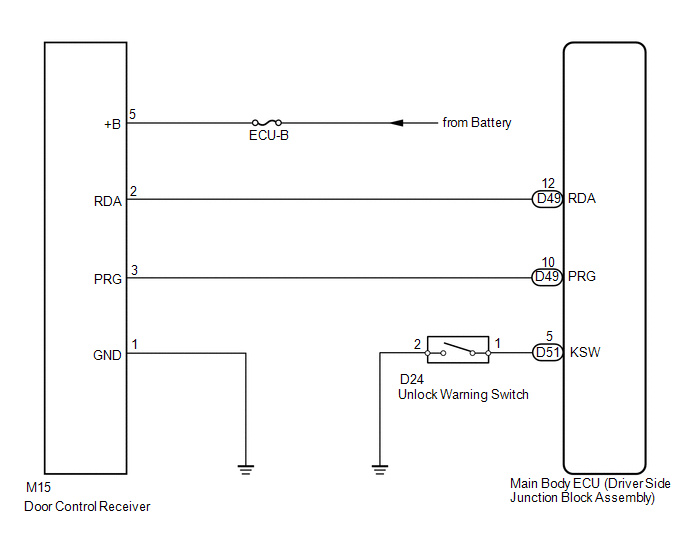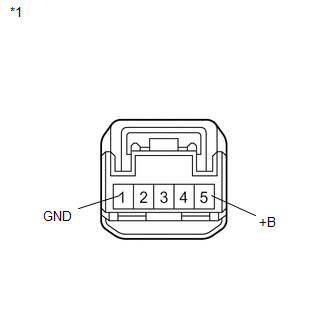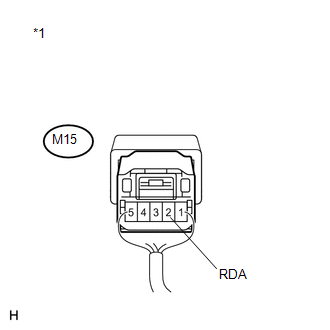Toyota Venza: Only Wireless Control Function is Inoperative
DESCRIPTION
The door control receiver receives signals from the transmitter and sends these signals to the main body ECU. The main body ECU then controls all doors by sending lock/unlock signals to each door, and sends hazard flasher relay signals to the turn signal flasher relay (hazard warning lights).
WIRING DIAGRAM

PROCEDURE
|
1. |
CHECK POWER DOOR LOCK OPERATION |
(a) When the door control switch on the master switch assembly is operated, check
that the locked doors unlock (See page .gif) ).
).
OK:
Locked doors unlock.
| NG | .gif) |
GO TO POWER DOOR LOCK CONTROL SYSTEM |
|
|
2. |
CHECK KEY REMINDER WARNING SYSTEM |
(a) Check that the key reminder warning buzzer operates normally.
OK:
Key reminder warning buzzer operates normally.
| NG | .gif) |
GO TO KEY REMINDER WARNING SYSTEM |
|
|
3. |
CHECK DOOR CONTROL TRANSMITTER ASSEMBLY |
(a) When known good registered door control transmitter is used, check that the wireless functions operate normally.
|
Result |
Proceed to |
|---|---|
|
Wireless door LOCK/UNLOCK function operates normally with a known good door control transmitter. |
A |
|
Wireless door LOCK/UNLOCK function does not operate. |
B |
| B | .gif) |
GO TO STEP 5 |
|
|
4. |
CHECK TRANSMITTER BATTERY |
(a) Inspect the battery capacity.
(1) Remove the battery from the electrical key transmitter that does not operate
(See page .gif) ). Attach a lead wire (0.6 mm (0.0236
). Attach a lead wire (0.6 mm (0.0236
in.) in diameter or less including wire sheath) with tape or equivalent to the negative
(-) terminal.
NOTICE:
Do not wrap the lead wire around a terminal, wedge it between the terminals, or solder it. A terminal may be deformed or damaged, and the battery will not be able to be installed correctly.
|
(b) Carefully pull the lead wire out from the position shown in the illustration and install the previously removed transmitter battery. |
|
(c) Using an oscilloscope, check the transmitter battery voltage waveform.
.png)
HINT:
Measure the transmitter battery voltage while pressing the LOCK or UNLOCK switch on the transmitter.
Standard Voltage:
|
Item |
Content |
|---|---|
|
Tester Connection |
Battery positive (+) - Battery negative (-) |
|
Tool Setting |
0.5 V/DIV., 100 ms/DIV. |
|
Condition |
Ignition switch off, all doors closed and LOCK or UNLOCK switch is pressed |
|
Specified Condition |
2.2 to 3.2 V (Refer to the waveform) |
| OK | .gif) |
REPLACE DOOR CONTROL TRANSMITTER MODULE |
| NG | .gif) |
REPLACE TRANSMITTER BATTERY |
|
5. |
CHECK WAVE ENVIRONMENT |
(a) Bring the transmitter near the door control receiver, and perform a wireless operation check.
HINT:
- When the transmitter is brought near the door control receiver, the possibility of wave interference decreases, and it can be determined if wave interference is causing the problem symptom.
- If the inspection result is that the problem only occurs in certain locations or times of day, the possibility of wave interference is high. Also, added vehicle components may cause wave interference. If installed, remove them and perform the operation check.
OK:
Wireless functions operate normally.
| OK | .gif) |
END (AFFECTED BY WAVE INTERFERENCE) |
|
|
6. |
SWITCH TO SELF-DIAGNOSTIC MODE |
(a) Switch to self-diagnostic mode by operating the ignition key cylinder.
(1) Make sure that the vehicle is in its initial condition. Then insert the key into the ignition key cylinder and remove it.
(2) Within 5 seconds after removing the key, insert the key into the ignition key cylinder (ignition switch off). Then turn the ignition switch to ON and off.
(3) Within 30 seconds after turning the ignition switch off, perform the following operation 9 times: turn the ignition switch to ON and then off.
NOTICE:
If the system cannot enter self-diagnostic mode, the system returns to normal mode.
HINT:
- Turning the ignition switch to ON after the above operations have been completed ends self-diagnostic mode.
- Do not lock or unlock doors during self-diagnostic mode.
|
(b) Check that the system has switched to self-diagnostic mode by checking the room light output pattern. |
|
|
(c) Check that the system has switched to self-diagnostic mode by checking the wireless door lock buzzer output pattern. |
|
|
|
7. |
CHECK SELF DIAGNOSTIC MODE |
.png)
(a) Inspect the diagnostic outputs when the door control transmitter switch is held down. The diagnostic outputs can be checked by the flash patterns of the interior lights and the buzzer patterns of the wireless door lock buzzer.
|
Result |
Proceed to |
|---|---|
|
Normal wave (light flash pattern and buzzer pattern) is output. |
A |
|
Unmatching recognition code is output. |
B |
|
No diagnostic outputs. |
C |
| A | .gif) |
REPLACE MAIN BODY ECU (DRIVER SIDE JUNCTION BLOCK ASSEMBLY) |
| C | .gif) |
GO TO STEP 9 |
|
|
8. |
REGISTER RECOGNITION CODE |
(a) Check that the system can be switched to rewrite mode or add mode, and that
a recognition code can be registered (See page
.gif) ).
).
OK:
Recognition code can be registered.
| OK | .gif) |
END (GO TO OPERATION CHECK) |
| NG | .gif) |
GO TO STEP 13 |
|
9. |
CHECK DOOR CONTROL RECEIVER (RESPONSE) |
(a) Prepare the door control transmitter from another vehicle.
(b) Press and hold down the door control transmitter switch.
(c) Check that an unmatching recognition code is output.
OK:
Unmatching recognition code is output.
| OK | .gif) |
REPLACE DOOR CONTROL TRANSMITTER MODULE |
|
|
10. |
CHECK DOOR CONTROL RECEIVER (+B, GND) |
|
(a) Disconnect the door control receiver. |
|
(b) Measure the resistance according to the value(s) in the table below.
Standard Resistance:
|
Tester Connection |
Condition |
Specified Condition |
|---|---|---|
|
1 (GND) - Body ground |
Always |
Below 1 Ω |
(c) Measure the voltage according to the value(s) in the table below.
Standard Voltage:
|
Tester Connection |
Condition |
Specified Condition |
|---|---|---|
|
5 (+B) - Body ground |
Always |
11 to 14 V |
|
*1 |
Front view of wire harness connector (to Door Control Receiver) |
| NG | .gif) |
REPAIR OR REPLACE HARNESS OR CONNECTOR |
|
|
11. |
CHECK DOOR CONTROL RECEIVER (OUTPUT) |
|
(a) Measure the voltage according to the value(s) in the table below. Standard Voltage:
|
|
| NG | .gif) |
REPLACE DOOR CONTROL RECEIVER |
|
|
12. |
CHECK HARNESS AND CONNECTOR (MAIN BODY ECU - DOOR CONTROL RECEIVER) |
|
(a) Disconnect the D49 main body ECU connector and the M15 door control receiver connector. |
|
(b) Measure the resistance according to the value(s) in the table below.
Standard Resistance:
|
Tester Connection |
Condition |
Specified Condition |
|---|---|---|
|
D49-12 (RDA) - M15-2 (RDA) |
Always |
Below 1 Ω |
|
D49-12 (RDA) - Body ground |
Always |
10 kΩ or higher |
|
D49-10 (PRG) - M15-3 (PRG) |
Always |
Below 1 Ω |
|
D49-10 (PRG) - Body ground |
Always |
10 kΩ or higher |
|
*1 |
Front view of wire harness connector (to Main Body ECU (Driver Side Junction Block Assembly)) |
|
*2 |
Front view of wire harness connector (to Door Control Receiver) |
| NG | .gif) |
REPAIR OR REPLACE HARNESS OR CONNECTOR |
|
|
13. |
REPLACE DOOR CONTROL RECEIVER |
(a) Temporarily replace the door lock control receiver with a new or known good
one (See page .gif) ).
).
|
|
14. |
REGISTER RECOGNITION CODE |
(a) Perform the Registration procedure (See page
.gif) ).
).
|
|
15. |
CHECK DOOR CONTROL RECEIVER (OPERATION) |
(a) Check that the doors can be locked and unlocked by using the transmitter LOCK and UNLOCK switches.
OK:
Doors can be locked and unlocked using transmitter.
| OK | .gif) |
END (DOOR CONTROL RECEIVER WAS DEFECTIVE) |
| NG | .gif) |
REPLACE MAIN BODY ECU (DRIVER SIDE JUNCTION BLOCK ASSEMBLY) |
 Wireless Door Lock Tuner Circuit Malfunction (B1242)
Wireless Door Lock Tuner Circuit Malfunction (B1242)
DESCRIPTION
The door control receiver receives signals from the transmitter and sends these
signals to the main body ECU (driver side junction block assembly).
DTC No.
DTC De ...
Other materials about Toyota Venza:
Door Control Switch
Components
COMPONENTS
ILLUSTRATION
Inspection
INSPECTION
PROCEDURE
1. INSPECT DOOR CONTROL SWITCH ASSEMBLY
(a) Measure the resistance according to the value(s) in the table below.
Standard Resistance:
Tester Conn ...
Removal
REMOVAL
PROCEDURE
1. DISCONNECT CABLE FROM NEGATIVE BATTERY TERMINAL
NOTICE:
When disconnecting the cable, some systems need to be initialized after the cable
is reconnected (See page ).
2. REMOVE UPPER CONSOLE PANEL SUB-ASSEMBLY (w/o Seat Heater Syste ...
On-vehicle Inspection
ON-VEHICLE INSPECTION
PROCEDURE
1. INSPECT CENTER AIRBAG SENSOR ASSEMBLY (VEHICLE NOT INVOLVED IN COLLISION)
(a) Perform a diagnostic system check (See page
).
2. INSPECT CENTER AIRBAG SENSOR ASSEMBLY (VEHICLE INVOLVED IN COLLISION AND AIRBAG
HAS NOT D ...
0.1407

.gif)
.png)
.png)
.png)


.png)
